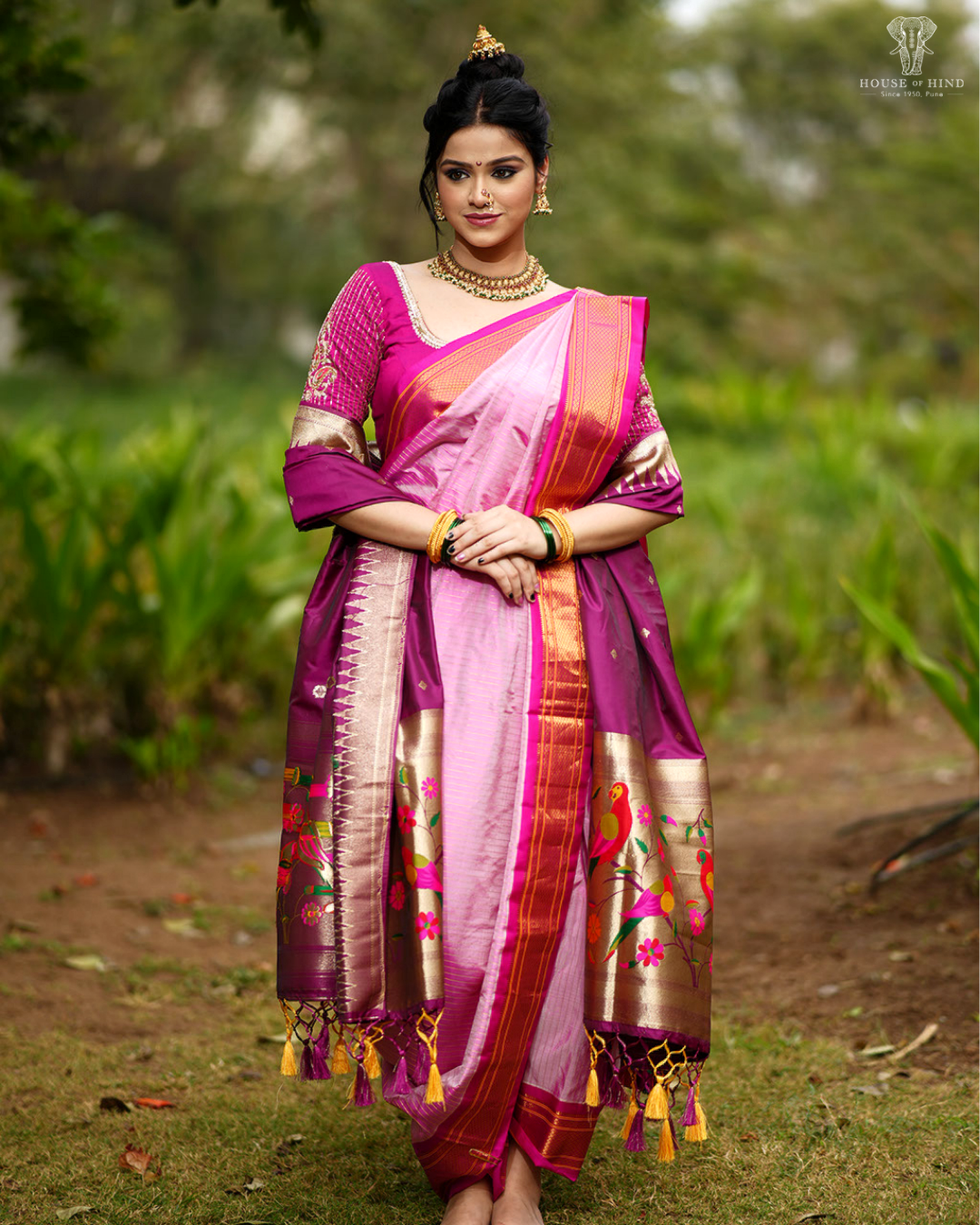Understanding the Regional Variations in Paithani Sarees

Regional Variations in Paithani Sarees
Paithani sarees, known for their luxurious silk and intricate zari work, are primarily associated with the town of Paithan in Maharashtra. However, over the centuries, this exquisite handloom craft has evolved with regional influences, resulting in unique variations. Each region adds its own flair, motifs, and weaving techniques while staying true to the traditional essence of Paithani sarees. Let’s explore the fascinating regional variations in Paithani sarees.
1. Paithan Paithani (Original Paithani)
-
Origin: Paithan, Maharashtra.
-
Key Features:
-
Considered the purest form of Paithani sarees, they are characterized by heavy zari work and traditional motifs like peacocks, lotuses, and narali (coconut).
-
The pallu often showcases large, elaborate designs with gold and silver zari.
-
Known for vibrant colors like red, green, yellow, and purple.
-
Cultural Significance: These sarees are a staple for Maharashtrian bridal trousseaus and festive occasions.
2. Yeola Paithani
-
Origin: Yeola, a town near Nashik, Maharashtra.
-
Key Features:
-
Known for slightly lighter sarees compared to Paithan’s heavier counterparts, making them more wearable.
-
Features simpler motifs like geometrical patterns, parrots, and flowers, with fewer zari elements.
-
Offers contemporary color palettes, including pastels and dual-tones, appealing to younger audiences.
-
Cultural Significance: Popular for semi-formal events and modern celebrations.
3. Aurangabad Paithani
-
Origin: Aurangabad, Maharashtra.
-
Key Features:
-
Incorporates intricate floral and creeper motifs, inspired by Mughal gardens.
-
Often features lighter zari work combined with elaborate silk thread designs.
-
Preferred for their intricate detailing and use of soft, muted shades alongside vibrant ones.
-
Cultural Significance: Ideal for formal and festive occasions, with a more delicate aesthetic.
4. Brocade Paithani
-
Origin: Influenced by regions where brocade weaving techniques are prominent, including Banaras.
-
Key Features:
-
Incorporates brocade patterns with intricate zari weaving for a rich, textured appearance.
-
Features heavy borders and densely designed pallus with motifs like paisleys and creepers.
-
Combines Paithani techniques with brocade artistry for an opulent finish.
-
Cultural Significance: Often reserved for weddings and grand occasions.
5. Contemporary Designer Paithani
-
Origin: Adapted from multiple regions to meet modern design trends.
-
Key Features:
-
Incorporates lighter fabrics and fusion motifs, blending traditional and modern elements.
-
Experimentation with color gradients, minimalistic zari work, and unconventional patterns.
-
Designed for versatility, suitable for both traditional and contemporary settings.
-
Cultural Significance: A favorite among younger generations for its adaptability.
6. Shikargah Paithani
-
Origin: Traced back to royal patronage across Maharashtra.
-
Key Features:
-
Features hunting scenes (shikargah), with motifs of animals like deer, elephants, and birds.
-
Extremely intricate and requires significant time and expertise to weave.
-
Made with heavier silk and zari, creating a regal and historic appeal.
-
Cultural Significance: Rare and often considered collector’s items, ideal for grand events or heirloom collections.
7. Narayan Peth Paithani
-
Origin: Narayan Peth, near Solapur, Maharashtra.
-
Key Features:
-
Recognized by its smaller, narrower borders with simple geometric patterns.
-
The pallu features modest designs, often in vibrant combinations of red and green.
-
Lighter and more affordable compared to traditional Paithanis.
-
Cultural Significance: Suitable for everyday wear or smaller ceremonies.
8. Gadwal Paithani
-
Origin: Inspired by the weaving traditions of Gadwal, Andhra Pradesh.
-
Key Features:
-
Combines the elegance of Paithani motifs with the durability of Gadwal cotton.
-
Borders and pallus feature zari work, while the body may use lighter silk or cotton blends.
-
Lightweight and versatile, catering to modern preferences.
-
Cultural Significance: Popular for casual and semi-formal occasions.
Key Differences Across Regions
|
Aspect |
Paithan |
Yeola |
Aurangabad |
Shikargah |
Narayan Peth |
|
Zari Work |
Heavy |
Moderate |
Moderate |
Heavy |
Minimal |
|
Motifs |
Peacock, Lotus |
Parrot, Flowers |
Creepers, Floral |
Hunting Scenes |
Geometric |
|
Fabric Weight |
Heavy |
Light-Medium |
Light-Medium |
Heavy |
Light |
|
Colors |
Traditional Bold |
Pastels, Brights |
Muted & Bright |
Regal Shades |
Vibrant Combos |
Conclusion
Regional variations in Paithani sarees reflect the diversity and adaptability of this traditional craft. From the bold and heavy Paithan originals to the lighter, modern designs of Yeola, each variation caters to different tastes and occasions. Whether you prefer traditional opulence or contemporary elegance, there’s a Paithani saree for every woman, making it a versatile and timeless addition to any wardrobe.
